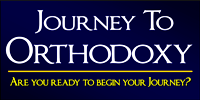 I have been fascinated to learn during my investigation of the Orthodox Church that Orthodoxy is not limited to Greek, Middle Eastern and Slavic ethnic groups. For the first millennium after Pentecost, all the churches of Europe were in communion with those in the East and until the Norman conquest of 1066, England itself was Orthodox.
I have been fascinated to learn during my investigation of the Orthodox Church that Orthodoxy is not limited to Greek, Middle Eastern and Slavic ethnic groups. For the first millennium after Pentecost, all the churches of Europe were in communion with those in the East and until the Norman conquest of 1066, England itself was Orthodox.The Church puts a lot of emphasis on the lives and writings of eastern heavyweights like St John Chrysostom and St Basil the Great. But the Western Church has also historically included big names like St Peter, St Joseph of Arimathea, St Irenaeus, St Ambrose, St Augustine, St Alban, St Dunstan, St Patrick, Pope St Gregory the Great
 , King Arthur, King Alfred the Great of England, and many others. Gregorian chant—named for St Gregory—Ambrosian chant—after St Ambrose—and the Latin Tridentine Mass all have historical roots in Western Orthodoxy. As do all the western Christian liturgies from the Anglican Book of Common Prayer to the Lutheran Divine Service.
, King Arthur, King Alfred the Great of England, and many others. Gregorian chant—named for St Gregory—Ambrosian chant—after St Ambrose—and the Latin Tridentine Mass all have historical roots in Western Orthodoxy. As do all the western Christian liturgies from the Anglican Book of Common Prayer to the Lutheran Divine Service.In fact, Orthodoxy thrived in western Europe until the middle of the 11th century, when, following its split with the East, Rome sought the allegiance of western European churches. Most followed without resistance. Those in England did not.
 With the blessing of Pope Alexander II, Duke William (the Conqueror) of Normandy launched an invasion with the intention of bringing England into communion with Rome. On October 14, 1066, Harold II (Godwinson), England’s last Orthodox king died in battle at Hastings, as did the ancient Anglo-Saxon Orthodox Church. The demise of the Celtic Orthodox churches of Ireland, Scotland, and Wales followed shortly.
With the blessing of Pope Alexander II, Duke William (the Conqueror) of Normandy launched an invasion with the intention of bringing England into communion with Rome. On October 14, 1066, Harold II (Godwinson), England’s last Orthodox king died in battle at Hastings, as did the ancient Anglo-Saxon Orthodox Church. The demise of the Celtic Orthodox churches of Ireland, Scotland, and Wales followed shortly.Thus the liturgies, traditions and heritage of the Western Church were lost to Orthodoxy.
It wasn’t until the nineteenth century that a group of western converts to Orthodoxy, wishing to retain the forms of worship familiar to them, reintroduced western liturgies into the Orthodox Church.
There are currently two liturgies in use by Western Rite Orthodox churches in the United States:
The Liturgy of St. Tikhon was developed from the 1928 American Book of Common Prayer and the Anglican Missal, both of which were, in fact, adapted from ancient Orthodox liturgies.
The Liturgy of St Gregory is a revised version of the Roman Tridentine Mass, which was modified to remove the filioque and insert a Byzantine epiclesis.
Twenty-six Antiochian and five ROCOR (Russian Orthodox Church Outside of Russia) parishes and monasteries in the United States, Canada, Australia, and New Zealand currently celebrate the Western Rite Mass.
The church I have been attending, Holy Incarnation, is an Antiochian mission that celebrates the Western Mass. It is a very young (just over a year old), very small mission, and to my knowledge is the only Western Orthodox parish in the Midwest. It is fully orthodox, and in full communion with the greater body of Orthodox churches.
For more information:
Western Orthodoxy
Antiochian Western Rite
Western Orthodox (blog)





No comments:
Post a Comment